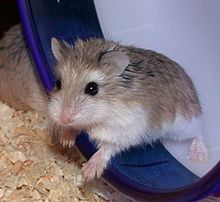Roborovski hamster
| Roborovski hamster | |
|---|---|
 |
|
| Scientific classification | |
| Kingdom: | Animalia |
| Phylum: | Chordata |
| Class: | Mammalia |
| Order: | Rodentia |
| Family: | Cricetidae |
| Subfamily: | Cricetinae |
| Genus: | Phodopus |
| Species: | P. roborovskii |
| Binomial name | |
|
Phodopus roborovskii (Satunin, 1903) |
|
 |
|
| Distribution of P. roborovskii | |
Roborovski hamsters (Phodopus roborovskii; formerly Cricetulus bedfordiae) also known as desert hamsters or Robos are the smallest of three species of hamster in the genus Phodopus, averaging under 2 centimetres (0.8 in) at birth and 4.5–5 centimetres (1.8–2.0 in) and 20–25 grams (0.71–0.88 oz) during adulthood. Distinguishing characteristics of the Roborovskis are eyebrow-like white spots and the lack of any dorsal stripe (found on the other members of the Phodopus genus). The average lifespan for the Roborovski hamster is three years, though this is dependent on living conditions (extremes being four years in captivity and two in the wild). Roborovskis are known for their speed and have been said to run an equivalent of four human marathons each night on average.
Roborovski hamsters are found in desert regions, such as the basin of the lake Zaysan in Kazakhstan and regions of Tuva, Mongolia and Xinjiang in China. The hamsters inhabit areas of loose sand and sparse vegetation and are rarely found in areas of dense vegetation and solid clay substrates. They live at elevations of around 1,200 metres (3,900 ft)–1,450 metres (4,760 ft) and although research has been carried out, no fossil record exists for this species. Their efficient use of water makes them particularly suited to the steppe and desert regions they inhabit. They dig and live in burrows with steep tunnels as deep as six feet underground. In the wild, Roborovski hamsters are crepuscular, being most active at dawn and dusk.
The Roborovski hamster has been found to be more common in the southern area of its distribution range, in areas such as Yulin, Shaanxi, China. It has been reported as a common sighting by locals in this city and in the sand dunes of the Ordos desert.
They are omnivorous; they primarily eat grains, vegetables, fruit, and plants, but they will also eat meat and insects in small quantities. Roborovski hamsters remain underground in winter and survive in that season by stockpiling some food in warmer weather and storing it in special food chambers within their burrow system.
The Roborovski hamster mainly feeds on seeds. In Tuva it primarily lives on the seed of the sand alyssum, Nitre Bush, Siberian peashrub, Dracocephalum peregrinum, and milkvetch as well as sedges during the summer-months. Vegetative plant parts are not of significance.
...
Wikipedia

